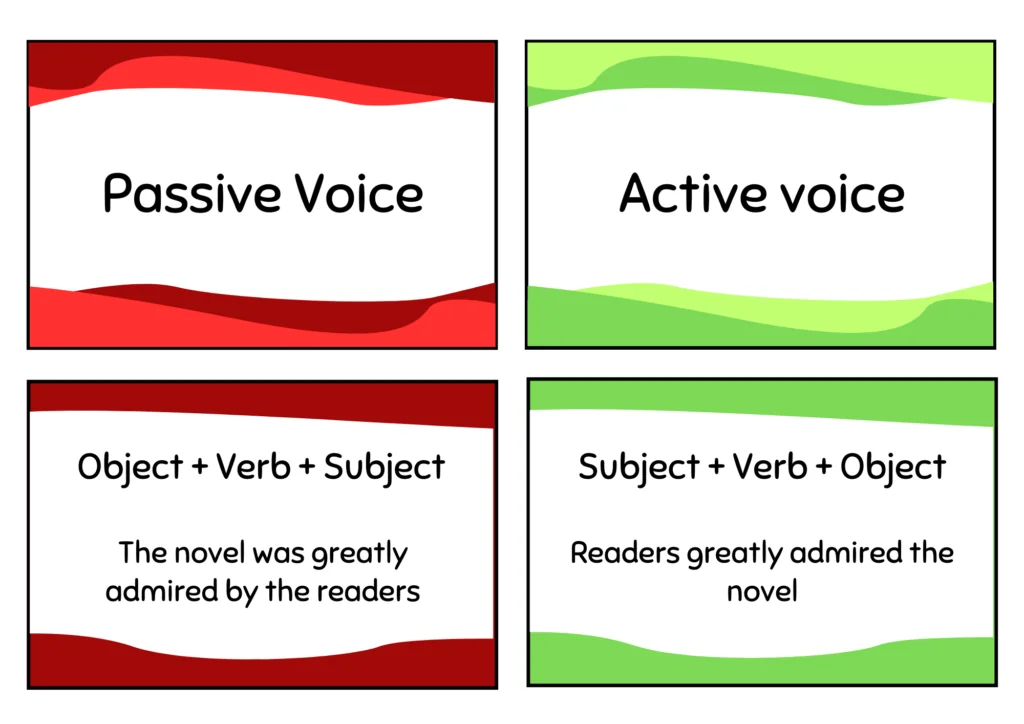Rewriting a sentence from passive to active voice will most probable help those of you who want to improve the clarity and impact of their writing. Active voice breathes life into your sentences, making them more direct and engaging. Can Chat GPT rewrite text for you? Sure, it can, but it is better to know how to do it yourself. Let’s explore the nuances of active and passive voice and the steps to master this rewriting process.

✅ AI Essay Writer ✅ AI Detector ✅ Plagchecker ✅ Paraphraser
✅ Summarizer ✅ Citation Generator
Passive vs Active Voice: What’s The Difference
So, active vs passive voice – what’s the deal between these two forms of sentences? In passive voice, the subject of the sentence is acted upon by the verb, often leading to longer, more convoluted sentences. For instance, “The car was purchased by Olivia” is in passive voice. On the contrary, active voice places the subject at the forefront, performing the action of the verb, resulting in shorter, punchier sentences, like “Olivia purchased the car.”

Active voice is often favored for its clarity and dynamism, which make it easier for readers to grasp the writer’s intentions and follow their line of thought. Using active voice sentences, where the subject acts, you can build more straightforward and engaging text. For example, compare the passive voice sentence “The experiment was conducted by the scientists” with the active voice version “The scientists conducted the experiment.” The latter is more direct and easier to understand, as it clearly identifies the doers of the action.
Passive voice also has its place in writing. Particularly when the focus is on the action or the object of the action rather than the subject. This can be useful in scientific writing or formal reports where the results or findings are more important than the researchers themselves. For instance, “The new species was discovered in the rainforest” emphasizes the discovery rather than the discoverers.
However, excessive use of passive voice can lead to problems in writing. It can make sentences longer and more complicated, which can confuse readers and mask the intended meaning. Jargon-filled writing, often a result of overusing passive voice, can be particularly challenging for readers to decode. For example:
- The passive voice sentence “The decision was reached by the committee after much deliberation”
- Can be made clearer and more concise in active voice as “The committee reached a decision after much deliberation.”
The 3-Step Active Voice Rewrite Process
As we found, rewriting sentences from passive to active voice can greatly enhance the clarity and impact of your writing. By following a simple three-step process, you can transform your sentences into more engaging and direct statements, if you don’t want to use an AI sentence rewriter free.
Identifying Passive Voice
The first step in the rewriting process is to identify sentences that are in passive voice.
Passive voice sentences typically contain a form of the verb “to be” (such as “was,” “were,” “is,” or “been”) followed by a past participle (the verb form usually ending in -ed, -en, or -t).
For example, look at the sentence “The cake was eaten by the children.” Here, “was eaten” is a clear indicator of passive voice.
Changing Word Order
Once you’ve identified a passive voice sentence, the next step is to change the word order to shift the focus from the action or object to the subject performing the action. This means moving the subject (the doer of the action) to the beginning of the sentence, followed by the verb, and then the object (the receiver of the action).
In our example, “The cake was eaten by the children” becomes “The children ate the cake.” Thus,the children, who are the ones eating, are now the focus of the sentence.
Removing Unnecessary Words
The final step in the process is to remove any words that are no longer needed after converting the sentence to active voice. Often, words like “by” that are used to introduce the doer of the action in passive voice sentences can be eliminated in active voice.
Following our example, the word “by” is removed when we convert the sentence to “The children ate the cake.” This step helps make the sentence more concise and easier to read.
Things to be Mindful of
When rewriting sentences in active voice, keep un mind a few complications that you can stumble upon during the rewriting process:
- The Sentence is Missing Details
Sometimes, the original sentence lacks specific details, particularly the subject. In passive voice, the focus is often on the action or the object of the action, and the doer of the action (the subject) might be omitted.
For instance, let’s take the passive voice sentence, “The novel was greatly admired.” The subject who admires the novel is not mentioned. When converting this sentence to active voice, you need to infer or add a subject based on the context, such as “Readers greatly admired the novel.” Adding the subject “Readers” completes the active voice sentence. - The Verb Needs Changing
When changing from passive to active voice, you may also need to alter the verb form to maintain the correct tense. This is because the verb form used in passive voice sentences (typically a form of “to be” plus a past participle) differs from that in active voice sentences.
As such, the passive voice sentence “The song was sung by the choir” needs to be changed to “The choir sang the song” in active voice. Here, the verb form changes from “was sung” to “sang” to keep the past tense consistent. - Use the Same Tense
Remember to stay consistent in terms of the used tense when converting from passive to active voice. If the original passive voice sentence is in the past tense, the converted active voice sentence should also be in the past tense.
Hence, if the passive sentence is “The project was completed by the team,” the corresponding active voice sentence should be “The team completed the project,” not “The team completes the project.”
Being mindful of these complexities, you can keep the rewritten sentences grammatically correct and clear.
Conclusion
Rewriting sentences from passive to active voice is a valuable strategy for students who need to boost the readability of their writing. The process of such rewriting takes only 3 steps and in the end you will be left with a much more logical and clearer text than before. So, maybe you can dig up a few old papers of yours and see how you can improve them using active voice? Just try and see!
FAQ
Follow us on Reddit for more insights and updates.





Comments (0)
Welcome to A*Help comments!
We’re all about debate and discussion at A*Help.
We value the diverse opinions of users, so you may find points of view that you don’t agree with. And that’s cool. However, there are certain things we’re not OK with: attempts to manipulate our data in any way, for example, or the posting of discriminative, offensive, hateful, or disparaging material.